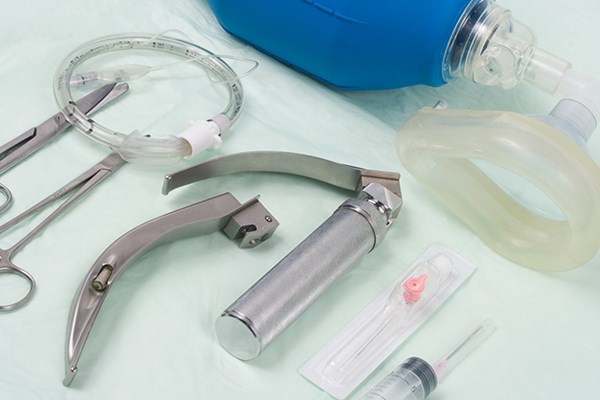We all learn our ABC's as kids, but after a couple years of medical school they take on a different meaning: airway, breathing, and circulation. In emergency medicine, rapid sequence intubation (RSI) comes into play when there is neither the time nor the luxury of adequately prepping a patient whose airway and breathing are compromised. This article will not be a complete or exhaustive resource for this topic, but it can serve as a starting point for medical students.
The concept of RSI is that the patient is sedated and paralyzed in order to allow for intubation without the application of artificial breaths via a bag valve mask (BVM). This is meant to prevent insufflation of the stomach and the risk of aspiration from vomiting – especially important in emergency patients who might have just finished their Big Mac before coming in or have conditions predisposing them to aspiration (GERD, traumatic brain injury, pregnancy, etc.).
Like everything else in medicine, RSI has a list of mnemonics to help us prepare for a successful intubation in stressful situations. Let's talk about the “P's” of RSI.
PREPARATION
This entails gathering and testing the supplies needed (endotracheal tubes, stylet, blades, handles, drugs, alternate airway methods) as well as planning for a surgical airway if orotracheal intubation ultimately fails. This step also involves stratifying the difficulty level of the patient's airway. A useful acronym for this is LEMON.
- Look: Observe for possible complications
- Evaluate: 3,3,2 rule for an easier intubation
- Fitting 3 fingers in an open mouth between upper and lower incisors
- Fitting 3 fingers between the edge of the chin and the hyoid bone
- Fitting 2 fingers between the hyoid bone and the notch of the thyroid cartilage
- Mallampati score: The more of the throat you can see, the easier it will be
- Obstruction: Possible foreign body, epiglottitis, edema, stridor, etc.
- Neck mobility: Anything that prevents ideal positioning of the neck, such as a c-collar, will make intubation more difficult
PREOXYGENATION
The goal in this step is to wash out as much nitrogen in the body to provide an oxygen reserve for the patient while they are apneic. This can be done with a non-rebreather mask on 15L O2 and 100% O2 nasal cannula before and during the procedure (termed “apneic” oxygen).
PRETREATMENT
This step is applied to select patients. Pretreatment done a few minutes prior to induction and paralysis is meant to mitigate the physiological response of the body to the procedure, as a catecholamine surge can result in increased sympathetic activity (elevated heart rate and blood pressure), increased intracranial pressure, and bronchospasm. Some emergency physicians may pretreat with lidocaine or fentanyl in trauma patients who might already have increased intracranial pressure. Some may also consider pretreatment with atropine in children less than 1 year of age.
PUTTING TO SLEEP/PARALYSIS
Given at the same time or quickly after induction.
- There are a few induction agents, but the big ones to consider are etomidate, ketamine, and propofol.
- Etomidate: 0.3 mg/kg IV, quick onset, lasts 3-12 minutes. Has a long history of use in RSI and is a common “go-to” choice. There is some concern that it may cause adrenal suppression in septic patients, but this is up for debate.
- Ketamine: 1.5 mg/kg IV or 4 mg/kg IM, onset in <1 minutes, lasts 10-20 minutes. Popular choice as it does triple duty as an anesthetic, amnestic, and analgesic. It causes bronchodilation and a catecholamine surge resulting in increased blood pressures and heart rate. Great in unstable sepsis patients and those with reactive airway disease. Avoid in cardiovascular disease. Rare report of laryngospasm.
- Propofol: 1.5-2.5 mg/kg IV, onset in 45 seconds, lasts 5-10 minutes. Use in hemodynamically stable patients, status epilepticus, and reactive airway disease. Watch for hypotension and myocardial depression.
- The common players in paralytic drugs are broken up into depolarizing and non-depolarizing agents. The only depolarizing agent is succinylcholine which mimics acetylcholine at the postsynaptic receptor and depolarizes the muscles fasciculations. There are more non-depolarizing agents, but the big ones are rocuronium and vecuronium.
- Succinylcholine: 1.5 mg/kg IV, onset in 45 seconds, lasts 5-10 minutes. Widely used but has many contraindications: hyperkalemia, recent crush or burn injury, and malignant hyperthermia.
- Rocuronium: 1.2 mg/kg IV, onset 60 seconds, lasts 15-40 minutes. Frequently used in children.
- Vecuronium: 0.15 mg/kg IV, onset 2-3 minutes, lasts 45-60 minutes. Generally avoided in RSI due to its duration of action.
POSITIONING
If possible, maneuver the patient into the ideal “sniffing” position. Place towels, blanket, or a wedge under the head until the ears align with suprasternal notch.
PLACEMENT OF THE TUBE
Visualize vocal cords, ask to be handed the ET tube without taking your eyes off the cords, and watch for passage through cords. Then, inflate the cuff.
POST-INTUBATION MANAGEMENT
Confirm proper placement. This can be done through auscultation of bilateral breath sounds, watching for equal chest rise, and end tidal CO2 (the gold standard). Next is securing the tube, placing on the ventilator, obtaining a confirmatory chest x-ray, and determining a post-intubation sedation plan.
Hopefully this bare-bones approach to RSI is enough to get you acquainted with the process, terminology, and medications. The more you demonstrate a general knowledge of the procedure, the more likely it is that you will have the opportunity to intubate someone yourself as a medical student.
Resources for Further Reading
Rapid Sequence Intubation Pharmacology
University of Maryland: Back to Basics- RSI Checklist
Special thanks to Abby Cosgrove, MD, for reviewing this clinical article.



